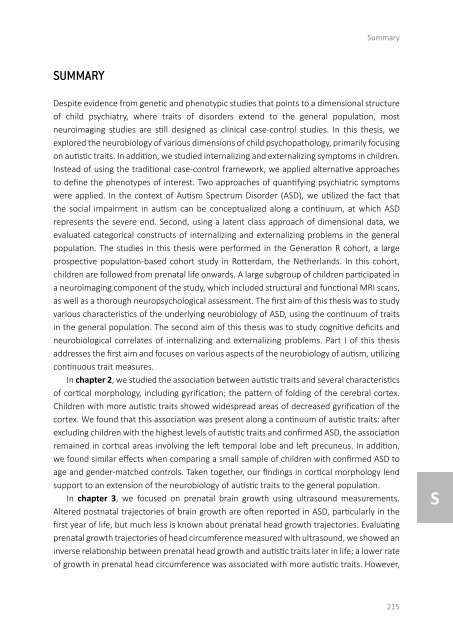On the Spectrum
2lm5UyR
2lm5UyR
Create successful ePaper yourself
Turn your PDF publications into a flip-book with our unique Google optimized e-Paper software.
Summary<br />
SUMMARY<br />
Despite evidence from genetic and phenotypic studies that points to a dimensional structure<br />
of child psychiatry, where traits of disorders extend to <strong>the</strong> general population, most<br />
neuroimaging studies are still designed as clinical case-control studies. In this <strong>the</strong>sis, we<br />
explored <strong>the</strong> neurobiology of various dimensions of child psychopathology, primarily focusing<br />
on autistic traits. In addition, we studied internalizing and externalizing symptoms in children.<br />
Instead of using <strong>the</strong> traditional case-control framework, we applied alternative approaches<br />
to define <strong>the</strong> phenotypes of interest. Two approaches of quantifying psychiatric symptoms<br />
were applied. In <strong>the</strong> context of Autism <strong>Spectrum</strong> Disorder (ASD), we utilized <strong>the</strong> fact that<br />
<strong>the</strong> social impairment in autism can be conceptualized along a continuum, at which ASD<br />
represents <strong>the</strong> severe end. Second, using a latent class approach of dimensional data, we<br />
evaluated categorical constructs of internalizing and externalizing problems in <strong>the</strong> general<br />
population. The studies in this <strong>the</strong>sis were performed in <strong>the</strong> Generation R cohort, a large<br />
prospective population-based cohort study in Rotterdam, <strong>the</strong> Ne<strong>the</strong>rlands. In this cohort,<br />
children are followed from prenatal life onwards. A large subgroup of children participated in<br />
a neuroimaging component of <strong>the</strong> study, which included structural and functional MRI scans,<br />
as well as a thorough neuropsychological assessment. The first aim of this <strong>the</strong>sis was to study<br />
various characteristics of <strong>the</strong> underlying neurobiology of ASD, using <strong>the</strong> continuum of traits<br />
in <strong>the</strong> general population. The second aim of this <strong>the</strong>sis was to study cognitive deficits and<br />
neurobiological correlates of internalizing and externalizing problems. Part I of this <strong>the</strong>sis<br />
addresses <strong>the</strong> first aim and focuses on various aspects of <strong>the</strong> neurobiology of autism, utilizing<br />
continuous trait measures.<br />
In chapter 2, we studied <strong>the</strong> association between autistic traits and several characteristics<br />
of cortical morphology, including gyrification; <strong>the</strong> pattern of folding of <strong>the</strong> cerebral cortex.<br />
Children with more autistic traits showed widespread areas of decreased gyrification of <strong>the</strong><br />
cortex. We found that this association was present along a continuum of autistic traits: after<br />
excluding children with <strong>the</strong> highest levels of autistic traits and confirmed ASD, <strong>the</strong> association<br />
remained in cortical areas involving <strong>the</strong> left temporal lobe and left precuneus. In addition,<br />
we found similar effects when comparing a small sample of children with confirmed ASD to<br />
age and gender-matched controls. Taken toge<strong>the</strong>r, our findings in cortical morphology lend<br />
support to an extension of <strong>the</strong> neurobiology of autistic traits to <strong>the</strong> general population.<br />
In chapter 3, we focused on prenatal brain growth using ultrasound measurements.<br />
Altered postnatal trajectories of brain growth are often reported in ASD, particularly in <strong>the</strong><br />
first year of life, but much less is known about prenatal head growth trajectories. Evaluating<br />
prenatal growth trajectories of head circumference measured with ultrasound, we showed an<br />
inverse relationship between prenatal head growth and autistic traits later in life; a lower rate<br />
of growth in prenatal head circumference was associated with more autistic traits. However,<br />
S<br />
215


